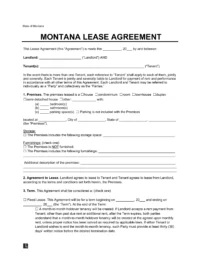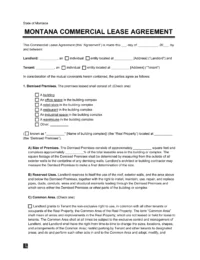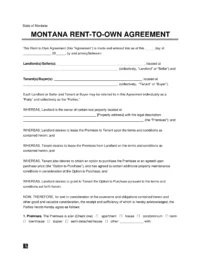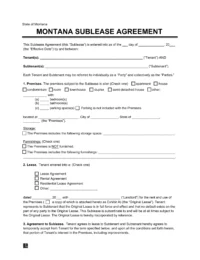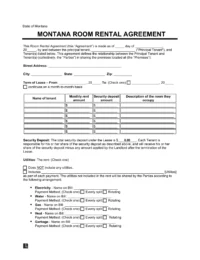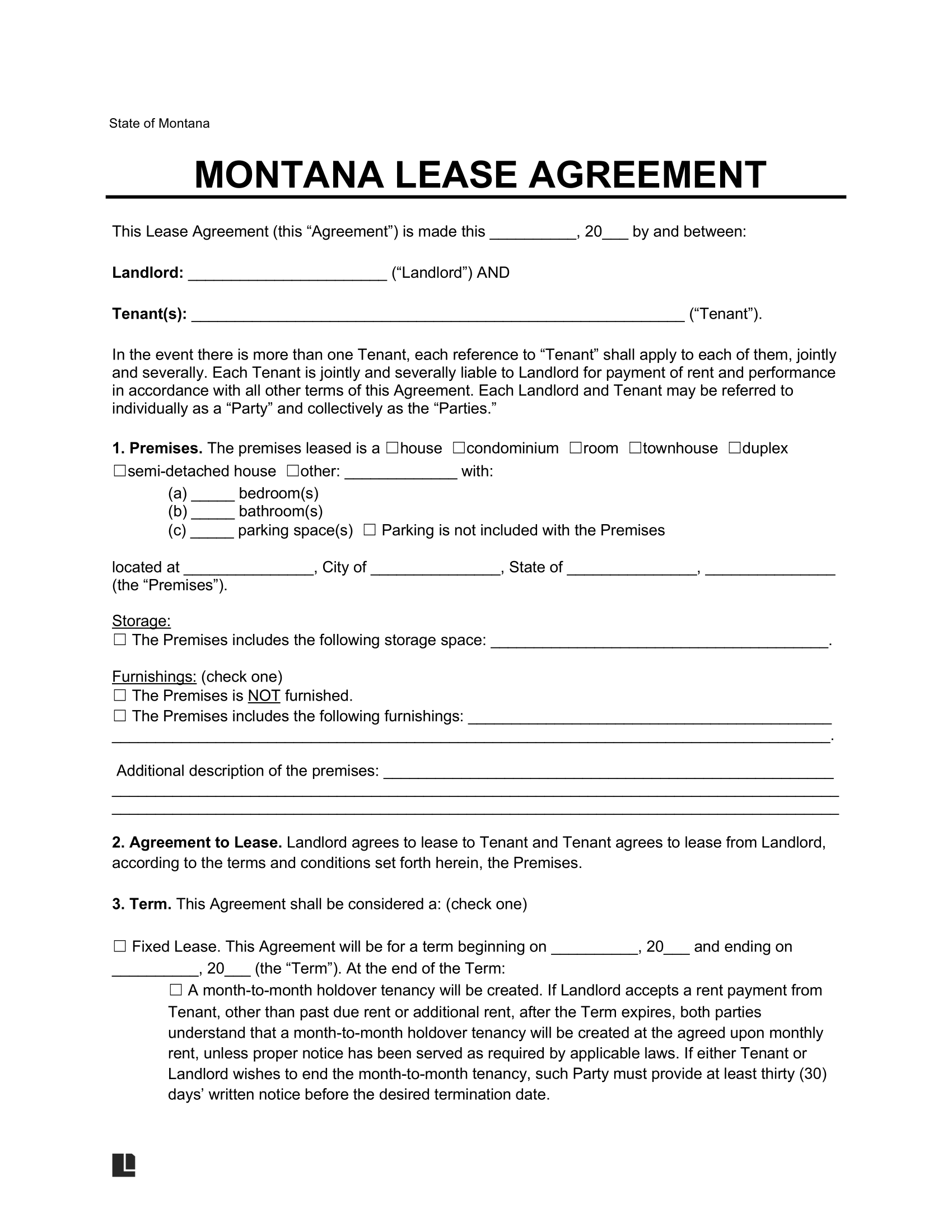A Montana lease agreement is a legal document that helps a landlord rent out a property and state all their terms for the tenant.
Written rental agreements make it easier and less risky to comprehensively define and describe all the rental property conditions, including the lease term, monthly payment, utilities, parking, late fees, and other items related to leasing a Montana rental.
Rental Lease Laws Overview
- Rent Control: No
- Limit on Late Fees: No
- Late Fees in Rental Agreement: Yes
- Grace Period: No
- License Required for Landlord: Yes
Landlords use rental applications to assess whether prospective tenants are a good fit before finalizing a lease agreement.
By Type (6)
Montana Standard Lease Agreement
By signing this document, both the landlord and tenant agree to abide by the terms and conditions for renting a residential property.
Montana Commercial Lease Agreement
Permits an entity to enter into a tenancy so they can use a property for business purposes.
Montana Rent-to-Own Lease Agreement
Establishes a traditional lease agreement and lets the tenant buy the property at the end of the rental period if they want to.
Montana Month-to-Month Rental Agreement
This agreement is subject to monthly renewal, with no specified termination date.
Montana Sublease Agreement
A secondary leasing arrangement is established, maintaining the primary tenant's responsibility to the original landlord.
Montana Room Rental Agreement
Allows tenants to establish usage guidelines and financial commitments for a rented room within a larger space
Required Lease Disclosures
Familiarize yourself with the disclosures a landlord must include in a lease agreement in Montana:
- Lead-based paint: A landlord renting a residence that was built before 1978 must include a notice that the property may contain harmful lead-based paint. [1]
- Methamphetamine production: According to the Montana Code, a landlord must notify a prospective tenant if their property was once used as a space for producing methamphetamine. [2]
- Presence of mold: A landlord must declare they don’t have knowledge of mold on the premises and provide records of any past instances of mold on the property. [3]
- Move-in checklist: Once a tenant provides a landlord with a security deposit, the landlord must provide a move-in checklist. The tenant can use this document as guidance to inspect the property themselves and check for any existing damage. [4]
- Manager information: The landlord must include the contact information of the manager who has authorization to enter the premises. [5]
Security Deposit
- Maximum Amount: No state-mandated limit.
- Receipts: Montana law does not require landlords to provide receipts for security deposits.
- Interest Payments: Landlords are not required to pay interest on security deposits.
- Bank Account: There is no requirement for landlords to hold security deposits in a separate bank account.
- Returning Requirements: The landlord must return the security deposit within 30 days after the lease ends. If the landlord fails to do so, the tenant can take the matter to small claims court. [6]
- Withholding Rules: If the property’s condition is in good shape upon moving out, a tenant is entitled to receive their entire security deposit within ten days. [6] If the landlord has to make deductions, they must give the tenant an itemized statement and the appropriate funds within 30 days. [7]
Rent Payment
- Laws: Rent is typically due at the beginning of the month unless otherwise specified in the lease agreement.
- Rent Control: Montana does not have rent control laws, meaning there is no cap on the rent amount a landlord can charge. Landlords are prohibited from retaliating against tenants for exercising their legal rights.
- Late Fees and Grace Period: Montana does not regulate the amount landlords can charge for late fees. Landlords must provide a notice before evicting a tenant for non-payment of rent. [8]
- Withholding Rent: Additionally, tenants may make repairs costing up to one month’s rent and deduct the cost from their rent if the landlord does not act in a reasonable time. For emergency repairs, tenants may use qualified repair professionals. [9]
Landlord Right of Entry
- Notice Requirements: Unless there’s an emergency, a landlord must provide the tenant with at least 24 hours’ notice before they enter the property. [10]
- Keys, Locks, and Security: Tenants and landlords must obtain explicit permission from each other before changing the locks.
Property Repairs in Montana
- Landlord Responsibilities
- Maintain Livability: Landlords must ensure that rental properties are livable and adhere to health and safety standards. This includes making timely repairs and maintaining essential services such as heating, water, and electricity. [11]
- Timely Repairs: Landlords are required to address repair needs in a timely manner, especially those that impact the health and safety of tenants. [11]
- Tenant Responsibilities
- Maintain Property: Tenants are expected to keep the rental property clean and safe, use fixtures properly, and adhere to health and safety codes.
- Report Repairs: Tenants must promptly notify the landlord of any needed repairs to avoid further damage or issues.
- Abandonment and Utility Payments
- Mitigation of Damages: If a tenant breaks the lease, the landlord must take reasonable steps to mitigate damages rather than automatically assuming abandonment.
- Unpaid Utilities: Landlords must provide a 10-day notice to tenants if utilities are unpaid before taking any further action. [11]
Terminating a Lease
- Month-to-Month Tenancy: In Montana, either party may terminate a month-to-month tenancy by providing written notice at least 30 days before the end of the rental period.
- Unclaimed Property: Montana does not have a specific statute that requires landlords to keep unclaimed property for a set period.
Sample
Below is a Montana lease agreement template you can download as a PDF or Word file:


